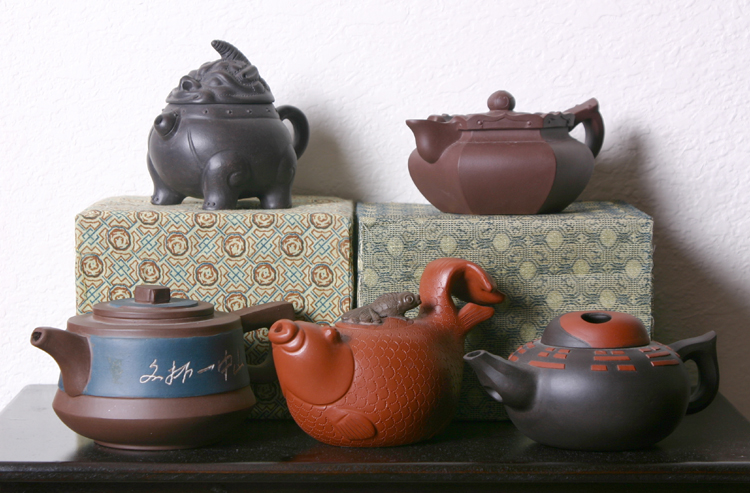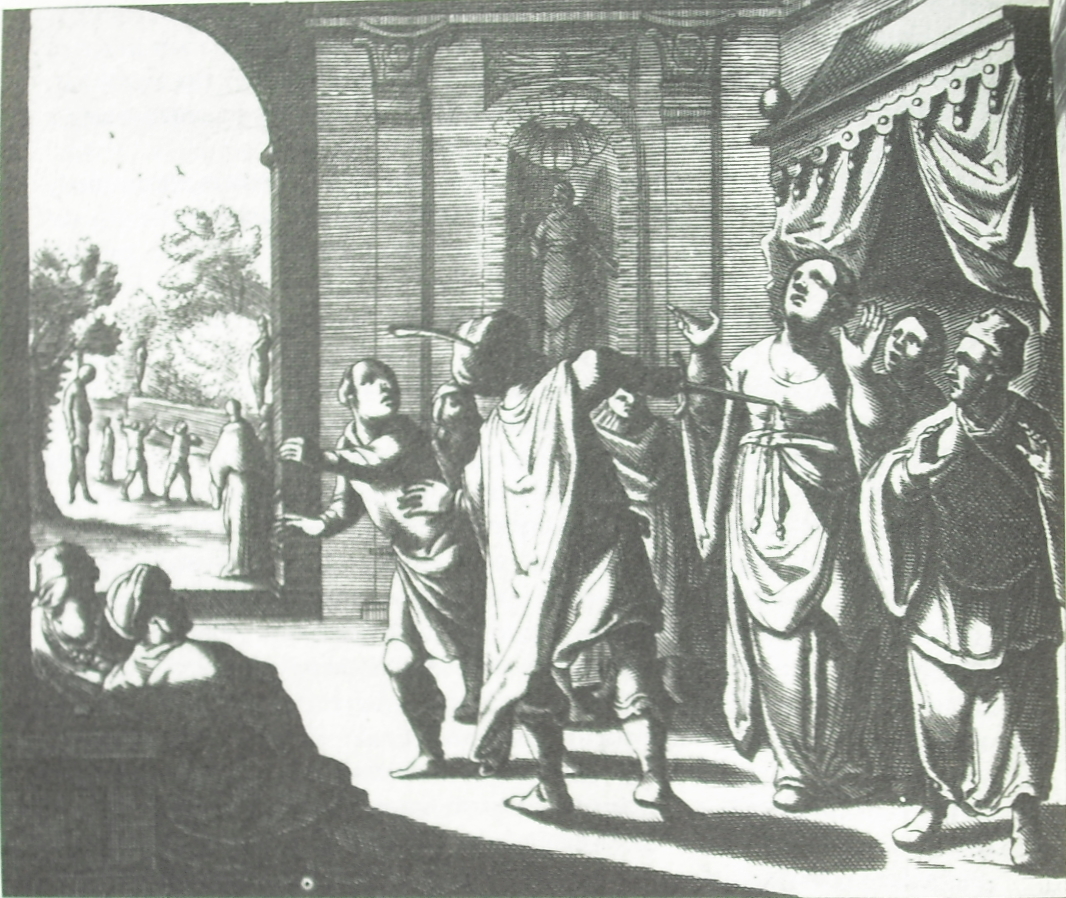|
On Yixing Teapots
''On Yixing Teapots'' (; with ''Yangxian'' being a Qin Dynasty name for Yixing) is a treatise on Yixing clay teapots written by Ming Dynasty author Zhou Gaoqi (''Chou Kao-chi;'' ; d. 1644вАУ45) in the Chongzhen The Chongzhen Emperor (6 February 1611 вАУ 25 April 1644), personal name Zhu Youjian, courtesy name Deyue,Wang Yuan (зОЛжЇР)пЉМ''Ju ye tang wen ji'' (гАКе±Еж•≠е†ВжЦЗйЫЖгАЛ), vol. 19. "иБЮдєЛеЉµжЩѓиФЪ趙и¶ЛзГИзЪЗеЄЭз•ЮдЄїй°МеЊ°иЂ±е≠ЧеЊЈзіДпЉМи°Мд ... era ca. 1640. In this book, Zhou provides a detailed account of the origin and history of Yixing teapots, followed by an account of the great masters and their disciples. Contents * Yixing Teapot Series * Origin of Yixing Teapots * Orthodox school * Yixing Teapot Masters * Famous Yixing Teapot Experts * Elegant styles * Magical Items * Diverse Schools of Yixing Teapot makers Notes References External links * *{{Baidu Baike , еС®йЂШиµЈ, 5866727 Chinese tea classic texts 17th-century books Teapots Yixing ... [...More Info...] [...Related Items...] OR: [Wikipedia] [Google] [Baidu] |
Yixing
Yixing () is a county-level city administered under the prefecture-level city of Wuxi in southern Jiangsu province, China, and is part of the Yangtze Delta, Yangtze River Delta. The city is known for its traditional Yixing ware, Yixing clay ware tea pots. It is a pene-exclave with Changzhou. The city spans an area of , and has a registered hukou population of about 1,075,800 as of 2020. History During the Xia dynasty and Shang dynasty, the area fell under the jurisdiction of Yangzhou and was known as Jingxi (). The area was subsequently known as Jingyi () during the Zhou dynasty. The area was first organized as a Counties of China, county in 221 BCE, during the Qin dynasty, under the name of Yangxian County (). Between 303 and 310 CE, local general Zhou Qi (Jin dynasty), Zhou Qi, a son of General Zhou Chu, suppressed three rebellions. Yangxian County was then renamed Yixing Commandery (), in honor of Zhou Qi. Yixing Commandery remained under the jurisdiction of Yangzhou. In 589 C ... [...More Info...] [...Related Items...] OR: [Wikipedia] [Google] [Baidu] |
Yixing Clay Teapot
Yixing clay teapots (), also called Zisha teapot (), are made from Yixing clay. This traditional style commonly used to brew tea originated in China, dating back to the 15th century, and are made from clay produced near Yixing in the eastern Chinese province of Jiangsu. History Archaeological excavations reveal that as early as the Song dynasty (10th century) potters near Yixing were using local "zisha" (зіЂз†В or зіЂж≥• ; literally, "purple sand/clay") to make utensils that may have functioned as teapots. According to the Ming dynasty author Zhou Gaoqi, during the reign of the Zhengde Emperor, a monk from Jinsha Temple (Golden Sand Temple) in Yixing handcrafted a fine quality teapot from local clay. The first Yixing clay teapots were made in the 16th century by monks from the Jinsha Temple. Their use was popularized by Kung Ch'un, who became a servant in the house of Yixing tea master Wu Lun (1440-1522). The new teapots soon became popular with the scholarly class, and th ... [...More Info...] [...Related Items...] OR: [Wikipedia] [Google] [Baidu] |
Ming Dynasty
The Ming dynasty, officially the Great Ming, was an Dynasties of China, imperial dynasty of China that ruled from 1368 to 1644, following the collapse of the Mongol Empire, Mongol-led Yuan dynasty. The Ming was the last imperial dynasty of China ruled by the Han people, the majority ethnic group in China. Although the primary capital of Beijing fell in 1644 to a rebellion led by Li Zicheng (who established the short-lived Shun dynasty), numerous rump state, rump regimes ruled by remnants of the House of Zhu, Ming imperial family, collectively called the Southern Ming, survived until 1662. The Ming dynasty's founder, the Hongwu Emperor (1368вАУ1398), attempted to create a society of self-sufficient rural communities ordered in a rigid, immobile system that would guarantee and support a permanent class of soldiers for his dynasty: the empire's standing army exceeded one million troops and the naval history of China, navy's dockyards in Nanjing were the largest in the world. H ... [...More Info...] [...Related Items...] OR: [Wikipedia] [Google] [Baidu] |
Zhou Gaoqi
Zhou may refer to: Chinese history * Predynastic Zhou ( or ; вАУ), the state in modern Shaanxi which established the Zhou dynasty * Zhou dynasty (; вАУ256 BC), a dynasty of China controlling Shaanxi, the North China Plain, and its periphery ** Western Zhou (; вАУ771 BC), ruling from present-day Xi'an ** Eastern Zhou (; 770вАУ256 BC), overseeing numerous petty states from present-day Luoyang * ( or ; вАУafter 580 BC), located in Zhoucheng (present-day Fengxiang District), the fief granted to Duke of Zhou's younger son Duke Ping of Zhou and his descendants, lasting at least until 580 BC under Chu * Western Zhou (state) (; 440вАУ256 BC), one of the Warring States in modern western Henan * Eastern Zhou (state) (; 367вАУ249 BC), one of the Warring States in modern eastern Henan * Northern Zhou (; 557вАУ581), a Xianbei state ruling western China from present-day Xi'an during the Northern and Southern Dynasties * Wu Zhou (; 690вАУ705), a brief interregnum of the Tang dynasty, ruling fro ... [...More Info...] [...Related Items...] OR: [Wikipedia] [Google] [Baidu] |
Chongzhen
The Chongzhen Emperor (6 February 1611 вАУ 25 April 1644), personal name Zhu Youjian, courtesy name Deyue,Wang Yuan (зОЛжЇР)пЉМ''Ju ye tang wen ji'' (гАКе±Еж•≠е†ВжЦЗйЫЖгАЛ), vol. 19. "иБЮдєЛеЉµжЩѓиФЪ趙и¶ЛзГИзЪЗеЄЭз•ЮдЄїй°МеЊ°иЂ±е≠ЧеЊЈзіДпЉМи°МдЇФпЉМзФЯжЦЉиРђжЫЖеЇЪжИМеНБдЇМжЬИдЇМеНБеЫЫжЧ•еѓЕжЩВпЉМеі©жЦЉеіЗз¶ОзФ≤зФ≥дЄЙжЬИеНБдєЭжЧ•дЄСжЩВгАВ" was the 17th and last emperor of the Ming dynasty. He reigned from 1627 to 1644. " Chongzhen", the era name of his reign, means "honorable and auspicious." Zhu Youjian was son of the Taichang Emperor and younger brother of the Tianqi Emperor, whom he succeeded to the throne in 1627. He battled peasant rebellions and was not able to defend the northern frontier against the Manchu. When rebels under Li Zicheng reached the capital Beijing in 1644, he committed suicide, ending the Ming dynasty. The Manchu formed the succeeding Qing dynasty. In 1645, Zhu Yousong, who had proclaimed himself the Hongguang Emperor of the Southern Ming dynasty, gave t ... [...More Info...] [...Related Items...] OR: [Wikipedia] [Google] [Baidu] |
Chinese Tea Classic Texts
Chinese may refer to: * Something related to China * Chinese people, people identified with China, through nationality, citizenship, and/or ethnicity **Han Chinese, East Asian ethnic group native to China. **''Zhonghua minzu'', the supra-ethnic concept of the Chinese nation ** List of ethnic groups in China, people of various ethnicities in contemporary China ** Ethnic minorities in China, people of non-Han Chinese ethnicities in modern China ** Ethnic groups in Chinese history, people of various ethnicities in historical China ** Nationals of the People's Republic of China ** Nationals of the Republic of China ** Overseas Chinese, Chinese people residing outside the territories of mainland China, Hong Kong, Macau, and Taiwan * Sinitic languages, the major branch of the Sino-Tibetan language family ** Chinese language, a group of related languages spoken predominantly in China, sharing a written script (Chinese characters in traditional and simplified forms) *** Standard Chine ... [...More Info...] [...Related Items...] OR: [Wikipedia] [Google] [Baidu] |
17th-century Books
The 17th century lasted from January 1, 1601 (represented by the Roman numerals MDCI), to December 31, 1700 (MDCC). It falls into the early modern period of Europe and in that continent (whose impact on the world was increasing) was characterized by the Baroque cultural movement, the latter part of the Spanish Golden Age, the Dutch Golden Age, the French ''Grand Siècle'' dominated by Louis XIV, the Scientific Revolution, the world's first public company and megacorporation known as the Dutch East India Company, and according to some historians, the General Crisis. From the mid-17th century, European politics were increasingly dominated by the Kingdom of France of Louis XIV, where royal power was solidified domestically in the civil war of the Fronde. The semi-feudal territorial French nobility was weakened and subjugated to the power of an absolute monarchy through the reinvention of the Palace of Versailles from a hunting lodge to a gilded prison, in which a greatly expanded r ... [...More Info...] [...Related Items...] OR: [Wikipedia] [Google] [Baidu] |
Teapots
A teapot is a vessel used for steeping tea leaves or a herbal tea, herbal mix in boiling or near-boiling water and serving the resulting infusion called tea; usually put in a teacup. It is one of the core components of teaware. Teapots usually have an opening with a lid at their top, where the dry tea and hot water are added, a handle for holding by hand, and a spout through which the tea is served. Some teapots have a strainer built-in on the inner edge of the spout. A small air hole in the lid is often created to stop the spout from teapot dribble, dripping and splashing when tea is poured. In modern times, a thermally insulating cover called a tea cosy may be used to enhance the steeping process or to prevent the contents of the teapot from cooling too rapidly. Dry tea is available either in tea bags or as loose tea, in which case a tea infuser or tea strainer may be of some assistance, either to hold the leaves as they steep or to catch the leaves inside the teapot when the ... [...More Info...] [...Related Items...] OR: [Wikipedia] [Google] [Baidu] |





